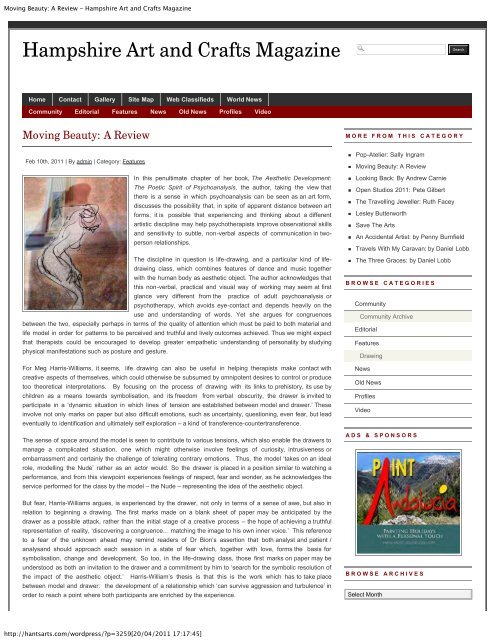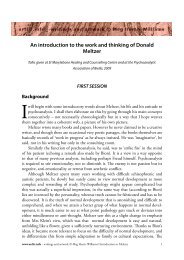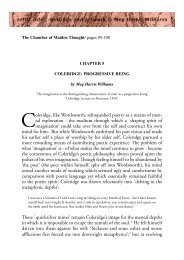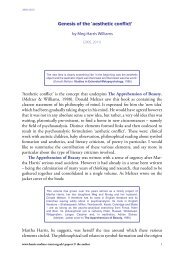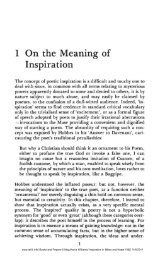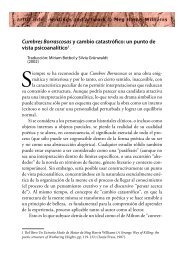Moving Beauty: A Review - Hampshire Art and Crafts Magazine - Artlit
Moving Beauty: A Review - Hampshire Art and Crafts Magazine - Artlit
Moving Beauty: A Review - Hampshire Art and Crafts Magazine - Artlit
You also want an ePaper? Increase the reach of your titles
YUMPU automatically turns print PDFs into web optimized ePapers that Google loves.
<strong>Moving</strong> <strong>Beauty</strong>: A <strong>Review</strong> - <strong>Hampshire</strong> <strong>Art</strong> <strong>and</strong> <strong>Crafts</strong> <strong>Magazine</strong><br />
<strong>Hampshire</strong> <strong>Art</strong> <strong>and</strong> <strong>Crafts</strong> <strong>Magazine</strong><br />
Home Contact Gallery Site Map Web Classifieds World News<br />
Community Editorial Features News Old News Profiles Video<br />
<strong>Moving</strong> <strong>Beauty</strong>: A <strong>Review</strong><br />
MORE FROM THIS CATEGORY<br />
Feb 10th, 2011 | By admin | Category: Features<br />
In this penultimate chapter of her book, The Aesthetic Development:<br />
The Poetic Spirit of Psychoanalysis, the author, taking the view that<br />
there is a sense in which psychoanalysis can be seen as an art form,<br />
discusses the possibility that, in spite of apparent distance between art<br />
forms, it is possible that experiencing <strong>and</strong> thinking about a different<br />
artistic discipline may help psychotherapists improve observational skills<br />
<strong>and</strong> sensitivity to subtle, non-verbal aspects of communication in twoperson<br />
relationships.<br />
The discipline in question is life-drawing, <strong>and</strong> a particular kind of lifedrawing<br />
class, which combines features of dance <strong>and</strong> music together<br />
with the human body as aesthetic object. The author acknowledges that<br />
this non-verbal, practical <strong>and</strong> visual way of working may seem at first<br />
glance very different from the practice of adult psychoanalysis or<br />
psychotherapy, which avoids eye-contact <strong>and</strong> depends heavily on the<br />
use <strong>and</strong> underst<strong>and</strong>ing of words. Yet she argues for congruences<br />
between the two, especially perhaps in terms of the quality of attention which must be paid to both material <strong>and</strong><br />
life model in order for patterns to be perceived <strong>and</strong> truthful <strong>and</strong> lively outcomes achieved. Thus we might expect<br />
that therapists could be encouraged to develop greater empathetic underst<strong>and</strong>ing of personality by studying<br />
physical manifestations such as posture <strong>and</strong> gesture.<br />
For Meg Harris-Williams, it seems, life drawing can also be useful in helping therapists make contact with<br />
creative aspects of themselves, which could otherwise be subsumed by omnipotent desires to control or produce<br />
too theoretical interpretations. By focusing on the process of drawing with its links to prehistory, its use by<br />
children as a means towards symbolisation, <strong>and</strong> its freedom from verbal obscurity, the drawer is invited to<br />
participate in a ‘dynamic situation in which lines of tension are established between model <strong>and</strong> drawer.’ These<br />
involve not only marks on paper but also difficult emotions, such as uncertainty, questioning, even fear, but lead<br />
eventually to identification <strong>and</strong> ultimately self exploration – a kind of transference-countertransference.<br />
The sense of space around the model is seen to contribute to various tensions, which also enable the drawers to<br />
manage a complicated situation, one which might otherwise involve feelings of curiosity, intrusiveness or<br />
embarrassment <strong>and</strong> certainly the challenge of tolerating contrary emotions. Thus, the model ‘takes on an ideal<br />
role, modelling the Nude’ rather as an actor would. So the drawer is placed in a position similar to watching a<br />
performance, <strong>and</strong> from this viewpoint experiences feelings of respect, fear <strong>and</strong> wonder, as he acknowledges the<br />
service performed for the class by the model – the Nude – representing the idea of the aesthetic object.<br />
Pop-Atelier: Sally Ingram<br />
<strong>Moving</strong> <strong>Beauty</strong>: A <strong>Review</strong><br />
Looking Back: By Andrew Carnie<br />
Open Studios 2011: Pete Gilbert<br />
The Travelling Jeweller: Ruth Facey<br />
Lesley Butterworth<br />
Save The <strong>Art</strong>s<br />
An Accidental <strong>Art</strong>ist: by Penny Burnfield<br />
Travels With My Caravan: by Daniel Lobb<br />
The Three Graces: by Daniel Lobb<br />
BROWSE CATEGORIES<br />
Community<br />
Community Archive<br />
Editorial<br />
Features<br />
Drawing<br />
News<br />
Old News<br />
Profiles<br />
Video<br />
ADS & SPONSORS<br />
But fear, Harris-Williams argues, is experienced by the drawer, not only in terms of a sense of awe, but also in<br />
relation to beginning a drawing. The first marks made on a blank sheet of paper may be anticipated by the<br />
drawer as a possible attack, rather than the initial stage of a creative process – the hope of achieving a truthful<br />
representation of reality, ‘discovering a congruence… matching the image to his own inner voice.’ This reference<br />
to a fear of the unknown ahead may remind readers of Dr Bion’s assertion that both analyst <strong>and</strong> patient /<br />
analys<strong>and</strong> should approach each session in a state of fear which, together with love, forms the basis for<br />
symbolisation, change <strong>and</strong> development. So too, in the life-drawing class, those first marks on paper may be<br />
understood as both an invitation to the drawer <strong>and</strong> a commitment by him to ‘search for the symbolic resolution of<br />
the impact of the aesthetic object.’ Harris-William’s thesis is that this is the work which has to take place<br />
between model <strong>and</strong> drawer: the development of a relationship which ‘can survive aggression <strong>and</strong> turbulence’ in<br />
order to reach a point where both participants are enriched by the experience.<br />
BROWSE ARCHIVES<br />
Select Month<br />
http://hantsarts.com/wordpress/?p=3259[20/04/2011 17:17:45]
<strong>Moving</strong> <strong>Beauty</strong>: A <strong>Review</strong> - <strong>Hampshire</strong> <strong>Art</strong> <strong>and</strong> <strong>Crafts</strong> <strong>Magazine</strong><br />
The ideas in this chapter are complex <strong>and</strong> we found the text often dense<br />
<strong>and</strong> challenging, both intellectually <strong>and</strong> personally. Harris-Williams<br />
argues from a position of considerable literary, philosophical <strong>and</strong><br />
psychoanalytical knowledge, referring frequently to the thoughts, ideas<br />
<strong>and</strong> writings of her own cultural ancestors <strong>and</strong> internal good objects,<br />
some of whom will be more or less well known to or read by her<br />
readers. Yet it is precisely the scope of her creative attempt to explore<br />
<strong>and</strong> develop these ideas, which must encourage the reader to<br />
persevere, in spite of sometimes stumbling when trying to underst<strong>and</strong>.<br />
STAY INFORMED<br />
Entries (RSS)<br />
Comments RSS)<br />
WHO WRITES<br />
admin<br />
By chance, as we were considering the possibility of reviewing this<br />
chapter, we heard a radio programme, entitled Inside the Life Drawing<br />
Class. During the programme, the presenter Anneka Rice interviewed<br />
both drawers <strong>and</strong> models in a North London class, inviting them to<br />
speak about their experience of life drawing. Although the class<br />
featured neither dance nor music, the participants touched on several of<br />
the themes raised in Harris-William’s chapter. For example, drawers<br />
spoke about their feelings of responsibility towards, <strong>and</strong> empathy for,<br />
the model; the fear of ‘messing up’ or producing a ‘bad’ drawing, one<br />
the model would not like; the fear of making the first mark on their paper, <strong>and</strong> the question whether they could<br />
achieve what they wanted. Others described a sense of privilege in being given permission to look, some seeing<br />
it as an extension of the study of their own bodies or an opportunity to reconnect with their real selves by<br />
responding in a direct <strong>and</strong> creative way to another human body. A model spoke about discovering himself<br />
though the eyes of others. The class was described as an interaction, an ‘unravelling theatre of the moment’<br />
where drawers could be in their own worlds yet connected <strong>and</strong> involved in a ‘voiceless conversation led by the<br />
model’ where what is valid is in the moment.<br />
These thoughts <strong>and</strong> experiences of ordinary drawers in an ordinary class connected considerably in our minds<br />
with the thesis proposed by Harris-Williams <strong>and</strong> encouraged us to put pen to paper to recommend this most<br />
thought-provoking chapter to both psychotherapists <strong>and</strong> those interested in life drawing.<br />
Anne Bloom <strong>and</strong> Wendy Hatto<br />
Glossary<br />
Good object: an object in this context usually refers to a person who is loved by the subject <strong>and</strong> experienced as<br />
benevolent.<br />
Internal good object: this refers to a person who has been experienced by the subject as important <strong>and</strong><br />
benevolent, to the extent that he/she/the experience is ‘taken in’ <strong>and</strong> becomes part of the subject’s mental<br />
structure.<br />
Transference-countertransference: in this context the term refers to the relationship between a therapist <strong>and</strong><br />
patient, or any ordinary two-person relationship, in which one person (the patient) relates to the other (the<br />
therapist) as though he/she were some formerly important object, usually from his/her early life. By contrast, the<br />
countertransference refers to the emotional response of the second person (the therapist) to the behaviour of the<br />
first person (the patient). These are perfectly ordinary interactions which occur in relationships but usually we are<br />
not aware of what is happening at the time.<br />
Analys<strong>and</strong>: a person who is being analysed but is also a student of psychoanalysis.<br />
2 COMMENTS TO “MOVING BEAUTY: A REVIEW”<br />
1. cecilia macagno says:<br />
March 7, 2011 at 6:47 pm<br />
I can’t write englishvery well. I’m an art psycotherapist, I read e <strong>and</strong> appreciate Meg Harris Williams. I<br />
wonder if she Knows anything about Authentic Movement <strong>and</strong> psicodinamic art therapy.<br />
But this is not the right way to ask her about, I suppose.<br />
http://hantsarts.com/wordpress/?p=3259[20/04/2011 17:17:45]
<strong>Moving</strong> <strong>Beauty</strong>: A <strong>Review</strong> - <strong>Hampshire</strong> <strong>Art</strong> <strong>and</strong> <strong>Crafts</strong> <strong>Magazine</strong><br />
2. Jillian McLaren says:<br />
March 14, 2011 at 11:57 am<br />
Congratulations Meg. Very inspiring, inviting me to follow up by reading the whole book, even though<br />
I found I had to re-read some of the above in order to make sense, but totally agree with, the depth<br />
of dialogue <strong>and</strong> interaction between the artist <strong>and</strong> the nude model. It is possible that <strong>Art</strong> college<br />
tutors <strong>and</strong> technicians would glean a great deal from reading your book.<br />
LEAVE A COMMENT<br />
Name (required)<br />
Mail (will not be published) (required)<br />
Website<br />
© 2011 <strong>Hampshire</strong> <strong>Art</strong> <strong>and</strong> <strong>Crafts</strong> <strong>Magazine</strong> | Powered by WordPress | Branford<strong>Magazine</strong> theme by Michael Oeser at DER PRiNZ<br />
Log in | 24 queries. 0.182 seconds.<br />
http://hantsarts.com/wordpress/?p=3259[20/04/2011 17:17:45]
. <br />
Spring Update 1 - Ham pshire <strong>Art</strong> <strong>and</strong> <strong>Crafts</strong> <strong>Magazine</strong> 07/03/2011 15:12<br />
<strong>Review</strong> of Lifedrawing chapter in The Aesthetic Development<br />
• Community<br />
o Community Archive<br />
• Editorial<br />
• Features<br />
o Drawing<br />
.~<br />
• Old News<br />
• Profiles<br />
• Video<br />
Spring Update 1<br />
Feb 10th, 2011 I By admin I Category: Editorial<br />
There are two new features in this update, the first a review of a chapter from a book written by<br />
the distinguished artist <strong>and</strong> writer Meg Harris Williams who has of course written for this<br />
magazine on life drawing. The chapter comes from The Aesthetic Development: The Poetic<br />
Spirit of Psychoanalysis <strong>and</strong> it is reviewed by two senior figures in the field of psychoanalytic<br />
psychotherapy: Anne Bloom, who has worked extensively with adults <strong>and</strong> families, <strong>and</strong> Wendy<br />
Hatto, a retired child <strong>and</strong> adolescent psychotherapist. Wendy Hatto has an interest in lifedrawing<br />
that goes back to when she was 19 years old. Whilst some of the language of<br />
psychoanalysis has entered everyday discourse, they have included a short glossary at the end<br />
of the review for less familiar terms.<br />
Freud's contribution to Western thought <strong>and</strong> culture is of course well documented. His<br />
articulation of the existence of the unconscious, its architecture <strong>and</strong> processes, has had a<br />
profound affect on all the arts. However, according to his biographer Peter Gay, Freud's views<br />
on the arts in relation to psychoanalysis were ambivalent, in that, while he was prepared to<br />
claim a great deal for the psychoanalytic study of an artist's character <strong>and</strong> of his reasons for<br />
choosing certain themes or fastening on certain metaphors, to say nothing of his effect on his<br />
audiences .. . he conceded that ... the nature of artistic achievement is indeed psychoanalyticaffy<br />
inaccessible to us. Freud, who had a formal scientific training in neurology, regarded<br />
psychoanalysis as in reality a method of research, an impartial instrument, rather like the<br />
infinitesimal calculus.<br />
In contrast to Freud, Meg Harris Williams works from the premise that psychoanalysis can be<br />
both a science <strong>and</strong> an art. In another chapter of her book she quotes the psychoanalyst Donald<br />
http://hantsarts.com/ wordpress /?p = 3298 Page 1 of 2
Spring Update 1 - <strong>Hampshire</strong> <strong>Art</strong> <strong>and</strong> <strong>Crafts</strong> <strong>Magazine</strong> 07/03/2011 15:12<br />
Meltzer as saying - The great artist <strong>and</strong> scientist has always been the same person. Harris <br />
Williams goes on to describe what art, science <strong>and</strong> religion share as they search for truth. <br />
Science <strong>and</strong> art merge into one another through observation <strong>and</strong> exploration of the sensuous <br />
world; art <strong>and</strong> religion through reverie <strong>and</strong> inner focus; religion <strong>and</strong> science through their respect <br />
for the idea of a reality that is neither invented nor imagined, but that exists beyond our desire <br />
<strong>and</strong> control. For those interested in discovering more, there is a workshop in Winchester on 21 <br />
May led by Meg Harris Williams <strong>and</strong> the artist Morag Donnelly. Click here for the electronic flier <br />
giving more details of the event <strong>and</strong> an application form. (Just click on the bottom right h<strong>and</strong> <br />
corner to turn pages.) <br />
A synthesis of art <strong>and</strong> science, <strong>and</strong> possibly religion, is also the subject of the second article. <br />
Written by Andrew Carnie, who is based in Winchester, it follows the course of his exhibitions <br />
<strong>and</strong> his developing ideas across America, Holl<strong>and</strong> <strong>and</strong> Engl<strong>and</strong> over the last two years. Carnie <br />
has studied chemistry, zoology <strong>and</strong> psychology as well as obtaining a BA in Fine <strong>Art</strong> from <br />
Goldsmiths <strong>and</strong> an MA in painting from The Royal College of <strong>Art</strong>. He has this to say about his <br />
work: <br />
The content of my work, the ideas for it, are sourced from science <strong>and</strong> interactions with <br />
scientists. I suppose a blending together of two interests, one an interest in the natural world the <br />
environment our biological make up <strong>and</strong> our behaviour <strong>and</strong> a strong interest in the arts; they <br />
were both areas that were cultivated in my childhood. I think art should have a subject <strong>and</strong> the <br />
field of science <strong>and</strong> scientific imagery <strong>and</strong> ideas to me is a very intriguing one. I have become <br />
very attracted to how we see our selves through scientific discovery <strong>and</strong> the theories it <br />
produces, trying to use this information to explore the ideas visually. <br />
A dialogue between art <strong>and</strong> science is of course not something new. As Richard Holmes has <br />
shown in his book The Age of Wonder, 19 th century scientists absorbed the notion of genius <br />
from the Romantic movement, <strong>and</strong> added a poetic, almost mystical sensibility to their search for <br />
knowledge. Wordsworth, writing of Sir Isaac Newton in The Prelude (or at least his statue, <br />
which st<strong>and</strong>s in Trinity College Cambridge), turned him, according to Holmes, into ahaunted <br />
<strong>and</strong> restless Romantic traveller amidst the stars. This I suppose should not be so surprising: the <br />
Portsmouth born historian Dame Francis A Yates has identified the roots of our rational post<br />
enlightenment science in the magical thinking of the Renaissance. <br />
There is news from the Isle of Wight Pottery Exhibition, now in its third year at the Ventnor <br />
Botanic Garden. Also from the Millais Gallery who until 27 March are showing an exhibition <br />
concerning British <strong>and</strong> Irish volunteers who fought against Franco during the Spanish Civil War. <br />
I've tweeted this appeal from the Southampton Hospital Charity already. You can read their <br />
press release by clicking here: The appeal is in aid of sufferers from blood cancer, among them <br />
the New Forest artist Anthony Lawrence who has a form of this condition known as Light Chain <br />
Multiple Myeloma. You can read about his progress on his website by clicking here. The charity <br />
has designated tomorrow Friday March 4 as Red <strong>and</strong> White Appeal Day: cl ick here for more <br />
information if you want to participate or make a donation. <br />
Leave a Comment<br />
<strong>Review</strong> of Lifedrawing chapter in The Aesthetic Development<br />
http://hantsarts.com/wordpressj7p= 3298 Page 2 of 2


